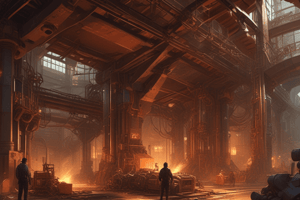Podcast
Questions and Answers
Which characteristic is NOT typically associated with cast iron?
Which characteristic is NOT typically associated with cast iron?
- Good casting property
- High tensile strength (correct)
- High wearing resistance
- High compressive strength
What is the approximate carbon content range for mild steel?
What is the approximate carbon content range for mild steel?
- 0.4 - 1.7%
- 0.15 - 0.25% (correct)
- 0.035 - 0.4%
- 1.7 - 6.8%
Which type of steel is known for its high resistance to corrosion and oxidation?
Which type of steel is known for its high resistance to corrosion and oxidation?
- Stainless Steel (correct)
- High Carbon Steel
- Mild Steel
- Cold Rolled Steel
What is a typical application for soft-centered steel?
What is a typical application for soft-centered steel?
Which of these carbon content ranges corresponds to a 'high carbon steel'?
Which of these carbon content ranges corresponds to a 'high carbon steel'?
What is the approximate percentage of carbon found in structural steel?
What is the approximate percentage of carbon found in structural steel?
Which of the following materials has the highest tensile strength according to the table?
Which of the following materials has the highest tensile strength according to the table?
What is the primary factor determining the lifespan and performance of agricultural machines?
What is the primary factor determining the lifespan and performance of agricultural machines?
Which of the following is an example of a non-ferrous metal?
Which of the following is an example of a non-ferrous metal?
Which aluminum alloy is known for being quenched at high temperature and then aged to increase strength?
Which aluminum alloy is known for being quenched at high temperature and then aged to increase strength?
What is a common application of brass, based on the text?
What is a common application of brass, based on the text?
What is the ore from which aluminum is produced?
What is the ore from which aluminum is produced?
What is the typical temperature inside a blast furnace used for metal production?
What is the typical temperature inside a blast furnace used for metal production?
Which copper alloy contains tin as its primary alloying element?
Which copper alloy contains tin as its primary alloying element?
Which of these materials is considered an organic material?
Which of these materials is considered an organic material?
What is a 'sheet' of metal defined as, in terms of thickness?
What is a 'sheet' of metal defined as, in terms of thickness?
What is a 'pig iron'?
What is a 'pig iron'?
According to the table, what is the Brinell hardness number for machinery steel?
According to the table, what is the Brinell hardness number for machinery steel?
Which of the following is NOT considered a non-ferrous material?
Which of the following is NOT considered a non-ferrous material?
What characteristic is NOT typically associated with metals?
What characteristic is NOT typically associated with metals?
What is the typical carbon content range of cast iron?
What is the typical carbon content range of cast iron?
What is the characteristic of metal that demonstrates its ability to resist being pulled apart?
What is the characteristic of metal that demonstrates its ability to resist being pulled apart?
Which of the following best describes a metal's ability to be deformed when stretched?
Which of the following best describes a metal's ability to be deformed when stretched?
If a metal bar is described as having a standard length of '20 ft or 6 meters', this characteristic relates most closely to which aspect?
If a metal bar is described as having a standard length of '20 ft or 6 meters', this characteristic relates most closely to which aspect?
Which material property describes a metal's ability to flow and join with other metals when in a liquid state?
Which material property describes a metal's ability to flow and join with other metals when in a liquid state?
What does the term 'malleability' describe in the context of a metal's mechanical properties?
What does the term 'malleability' describe in the context of a metal's mechanical properties?
Which of these is considered a physical property of metal?
Which of these is considered a physical property of metal?
What type of strength measures a material's resistance to being pulled apart?
What type of strength measures a material's resistance to being pulled apart?
A metal's resistance to permanent deformation is best described by which of the following properties?
A metal's resistance to permanent deformation is best described by which of the following properties?
Which material property allows a metal to return back to its original shape after an external force is removed?
Which material property allows a metal to return back to its original shape after an external force is removed?
Which of the following is NOT a typical application for rubber materials in engineering?
Which of the following is NOT a typical application for rubber materials in engineering?
Which term best describes the ease with which a metal can be cut or machined?
Which term best describes the ease with which a metal can be cut or machined?
What is the material property that indicates a metal's ability to withstand bending and twisting forces?
What is the material property that indicates a metal's ability to withstand bending and twisting forces?
What is a primary characteristic of plastics that makes them suitable for a wide range of applications?
What is a primary characteristic of plastics that makes them suitable for a wide range of applications?
Which of the following is a common application of fiber materials, particularly the oldest engineering fibers like jute, flax, and hemp?
Which of the following is a common application of fiber materials, particularly the oldest engineering fibers like jute, flax, and hemp?
Which material type is described as a non-crystalline or amorphous solid, often composed of silica, lime, and sodium carbonate?
Which material type is described as a non-crystalline or amorphous solid, often composed of silica, lime, and sodium carbonate?
Which of the following is NOT a typical type of glass?
Which of the following is NOT a typical type of glass?
Flashcards
Cast Iron
Cast Iron
A type of iron with 1.7-6.8% carbon content, known for its good casting properties and high wear resistance.
Mild Steel
Mild Steel
Steel with 0.15-0.25% carbon, known for being malleable, easy to cut, and weld.
High Carbon Steel
High Carbon Steel
Steel containing over 0.50% carbon, used for making springs and cutting tools due to its hardness.
Stainless Steel
Stainless Steel
Signup and view all the flashcards
Cold Rolled Steel
Cold Rolled Steel
Signup and view all the flashcards
Durability of Agricultural Machines
Durability of Agricultural Machines
Signup and view all the flashcards
Heavy Materials Impact
Heavy Materials Impact
Signup and view all the flashcards
Ferrous Metals
Ferrous Metals
Signup and view all the flashcards
Non-Ferrous Metals
Non-Ferrous Metals
Signup and view all the flashcards
Pure Metals
Pure Metals
Signup and view all the flashcards
Alloys
Alloys
Signup and view all the flashcards
Manufacturing Metals Process
Manufacturing Metals Process
Signup and view all the flashcards
Metal Characteristics
Metal Characteristics
Signup and view all the flashcards
Fusibility
Fusibility
Signup and view all the flashcards
Strength
Strength
Signup and view all the flashcards
Tensile Strength
Tensile Strength
Signup and view all the flashcards
Compressive Strength
Compressive Strength
Signup and view all the flashcards
Elasticity
Elasticity
Signup and view all the flashcards
Thermoplastics
Thermoplastics
Signup and view all the flashcards
Ceramics
Ceramics
Signup and view all the flashcards
Fibers
Fibers
Signup and view all the flashcards
Z Strips
Z Strips
Signup and view all the flashcards
Plate
Plate
Signup and view all the flashcards
Metal Bars
Metal Bars
Signup and view all the flashcards
Tubular Products
Tubular Products
Signup and view all the flashcards
Ductility
Ductility
Signup and view all the flashcards
Hardness
Hardness
Signup and view all the flashcards
Toughness
Toughness
Signup and view all the flashcards
Properties of Iron
Properties of Iron
Signup and view all the flashcards
Soft Steel
Soft Steel
Signup and view all the flashcards
Machinery Steel
Machinery Steel
Signup and view all the flashcards
Spring Steel
Spring Steel
Signup and view all the flashcards
Aluminum Alloy
Aluminum Alloy
Signup and view all the flashcards
Brass Use
Brass Use
Signup and view all the flashcards
Bronze Use
Bronze Use
Signup and view all the flashcards
Metal Sheets
Metal Sheets
Signup and view all the flashcards
Study Notes
Introduction
- Agricultural machinery durability, service, and cost depend on the materials used in manufacturing process
- Machines made from substandard materials wear out quickly
- Heavy materials reduce power requirements and performance
- Engineers need knowledge of materials' physical properties, processing, and effective utilization to minimize waste and spoilage
Classifications
- Metals:
- Ferrous: Iron and steel (cast iron, carbon steel, alloy steel)
- Non-ferrous: Aluminum, copper, magnesium
- Non-Metals:
- Inorganic: Glass, ceramics, plastics
- Organic: Wood, rubber, leather, canvas
Manufacturing Metals
- Metal ores are extracted from the earth
- Iron is produced from iron ore (hematite/magnetite), while copper from copper ore and Aluminum from bauxite
- Blast furnaces combine iron ore, limestone, and coke at high temperatures (around 3000°C) to produce molten metal
- Molten metal is separated into ladles for cooling to form pig iron
- Pig iron is then melted and poured into molds to create iron, steel, and cast iron
Metal Characteristics
- Hard
- Easy to shape
- High melting temperature
- Low specific heat
- Good electrical conductivity
- Good thermal conductivity
- Ability to be deformed without fracture
Classifications of Metal
- Pure Metal: A single element, often too soft or lacking desired properties for commercial use
- Alloys: Mixtures of two or more metals, creating new metals with improved properties (like stainless steel, bronze)
Iron
- Pure iron (ferrite): A base material for iron and steel production
- Pig iron: Produced from hematite or magnetite ore by melting with limestone and coke
- Cast iron: Contains 1.7-6.7% carbon, low cost, good casting properties, high compressive strength and wearing resistance, but is brittle and has lower tensile strength.
Steel
- Molten steel is cast into an ingot and then shaped (rolled, forged, hammered, pressed)
- Structural steel (bars, cylinders, plates) are often used in machine frames
- Soft Centered Steel - durable to shock because the mild steel layer in the center is more deformable and has higher wear resistance than the hard steel at the outside. Usually used in moldboards and plough shares
- Low Carbon Steel: Carbon content below 0.25%, malleable, easy to cut and weld
- Medium Carbon Steel: Carbon content 0.25-0.50%, used in structural and machinery steel
- High Carbon Steel: Carbon content above 0.50%, used to make springs and tool steel
- Mild Steel (MS): Contains carbon from 0.15 to 0.25%, malleable, easy to cut and weld.
- Cold Rolled Steel (CRS): Medium carbon steel, used in machine parts needing strength and hardness (e.g., shafting).
- Stainless Steel (SS): Contains 1% Ni, 11-14% Cr, 0.6% Mn, 0.6% Si. Highly resistant to corrosion and oxidation, used in valves, nozzles, and dairy equipment.
Typical Properties of Iron and Steel
- A table showing the properties of various steels according to Carbon content (e.g. Tensile strength, percentage of elongation, Brinell's hardness).
Non-Ferrous
- Metals excluding iron; e.g., copper, aluminum, magnesium, and zinc
Aluminum Alloy
- Outstanding characteristics: high strength, light weight, excellent thermal and electrical conductivity, and resistance to corrosion.
- Y alloy: Strong casting alloy, used in cylinder heads and pistons.
- Silmin: Casting alloy for cylinder heads and crankcases
- Duralumin: Alloy with copper, magnesium, and manganese. Quenched at high temperatures and then aged to enhance strength and hardness.
Aluminum Production
- Description of the process using electrolytic and casting methods
Copper and Its Alloys
- High electrical and thermal conductivity, soft, good resistance to corrosion.
- Brass: (10-40% zinc alloy) used in radiators, pipes, screens, and instrument parts.
- Bronze: (5-20% tin alloy) used in bushings, springs, pipes, fittings, sprayers, and pumps.
- Kelmet alloy: (20-40% lead alloy) used in diesel engine bearings
Copper Production
- Steps of copper production from ore (crushing, grinding, concentration, smelting, and electrolytic refining)
Properties of Copper Alloy
- A table summarizing properties and usage of copper alloys (e.g., brass, bronze, Kelmet).
Metal Shapes
- Sheets: Rolled metal, thin, in various sizes (width, length, gauge)
- Strips: Thin, flat, less than 12 inches wide
- Plates: Thick metal, larger sizes (width, length, thickness)
Common Shapes of Metal Bars and Sheets
- Illustrations of various structural shapes (hexagon, octagon, I-beam, H-beam, reinforcing bar, etc)
Metal Bars
- Metal bars, available in various shapes and lengths (20ft or 6 meters)
- Used in different industries and applications
Structural Shapes
- The use of steel in structural components like angles, tees, and channels for agricultural machinery constructions
- Specifications specify quantity, type, and dimension of parts
Tubular Products
-Hollow metal shapes (e.g. pipes and tubes) in round, square, and rectangular.
- Specifications including shape, schedule, size and length
Common Structural Shapes of Bars
Illustrations of various common shapes of metal bars
Properties of Metal
- Physical properties: Characteristics of metals not influenced by external forces (color, density, weight, electrical and heat conductivity)
- Mechanical properties: Characteristics of metals responding to applied external forces (tensile strength, yield strength, ductility, hardness, brittleness, compressibility, malleability, toughness)
- Chemical properties: Characteristics regarding chemical reactions and compositions (resistance to corrosion)
Mechanical Properties of Metal
- Tensile strength: Maximum stress a material can withstand before breaking
- Yield strength: Stress at which a material begins to deform permanently
- Ductility: Ability to deform or stretch without breaking
- Hardness: Resistance to penetration or deformation
- Brittleness: Tendency to break under impact
Additional Mechanical Properties
- Compressive strength: Resistance to compression
- Malleability: Ability to be shaped and formed by hammering
- Toughness: Ability to withstand bending and twisting
- Grain size: Microscopic measurement of metal’s grain structure influencing resistance to deformation and breaking
- Machinability: Ease with which metals can be machined (cut, shaped)
Additional Properties of Metal
- Fusibility: Ability of metal to be melted and joined
- Strength: Resistance to deformation
Non-Metallic Materials
- Wood: Includes sapwood (moisture-carrying) and heartwood (hard core)
- Plastics: A large group of organic materials: molded shapes, light weight, resistant to moisture, low thermal conductivity, wide color range
- Rubber: Extracted naturally; excellent at withstanding deformation; recovers quickly upon release of the force; has many applications in engineering like sealing, shock control, and production of various components
- Ceramics: Include glass, ceramic oxides, glass ceramics, carbides, and nitrides (used in high-temperature applications or parts where extreme resistance to wear and tear is crucial)
- Fibers: Plant/animal sources for ropes, containers, felt, paper, and heavy cloth. Metal fibers, glass fiber, aramid fibers (engineered fibers)
Plastic Processing
- Description of how plastic pellets are transformed into various forms through mechanical processing
Polymer Processing
- Description of process to create polymers from raw materials
Examples
- List of examples of acrylic, epoxy, fluoroplastic, nylon, phenolic resins, etc.
Engineering Ceramics
- Diverse group of materials including glass, ceramic oxides, and other similar materials.
Fibers
- A class of engineering materials (natural or synthetic) including jute, flax, hemp, metal fibers, Aramid, and glass fibers commonly used for reinforcement, support, rope making, and miscellaneous purposes
Glass
- A non-crystalline, amorphous solid, most often made from silica, lime, and soda
- Various types of glass like soda-lime, borosilicate, etc., with differing properties
Studying That Suits You
Use AI to generate personalized quizzes and flashcards to suit your learning preferences.




